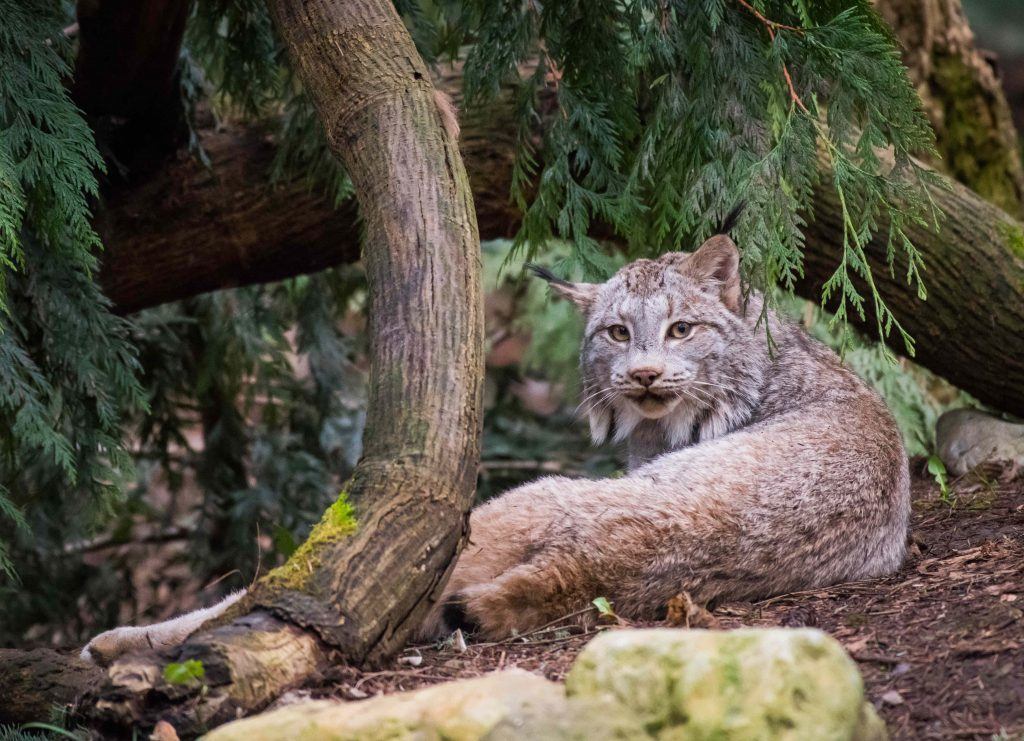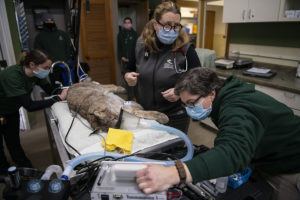
Baby animals are lovely – but for animals in human care, they need careful planning.
At Northwest Trek this November, that was the case for Nuka, a female Canada lynx who headed into the veterinary clinic one bright fall morning to get her contraceptive implant replaced. A fairly simple procedure, but one that came with a scientific backstory – and an opportunity for Nuka’s human team to care for her in a host of other ways as well.
“Okay, she’s looking great,” commented Dr. Allison Case, the wildlife park’s veterinarian, as Nuka was connected to a brand new portable anesthesia monitor. The lynx lay, peacefully anesthetized, on the surgical table’s comfy blanket, long legs stretched out and wide fluffy paws relaxed. One by one, Dr. Case examined Nuka’s huge amber eyes, giving them lubricating drops to stay moist during the procedure.
Then Dr. Case palpated Nuka’s lean body, her hands deep in thick beige fur.
“She’s feeling great too,” Dr. Case commented. “She’s put on weight.”
Cleaning Nuka’s claw sheaths, keeper Haley Withers nodded.
Helping Nuka’s pancreas
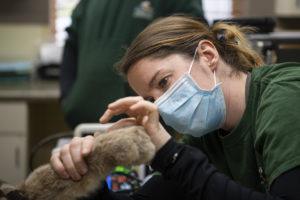
It wasn’t a routine check. A year ago Dr. Case had diagnosed Nuka with pancreatic insufficiency – her pancreas wasn’t doing its usual job in production and secretion of the enzymes which help her digest her diet. The lynx was losing weight, and showing signs of nutrient malabsorption and loose stools.
“When she wasn’t eating, she was about 23 pounds,” says Withers. “Then, after the treatment, she got to 23.5, then 24.”
Today, she’d weighed in at 26 pounds – perfect.
“Every day she gets an enzyme powder that helps break down her food for her,” Withers explains. “We put a teaspoon in her ground meat, and it does the job her pancreas can’t do. We’ve seen a big difference – she’s eating well, keeping the weight on.”
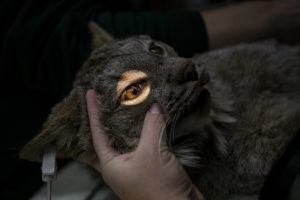
That pancreatic insufficiency could also pose challenges if Nuka were to get pregnant, both genetically and for weight management.
It’s an issue, since Nuka and her mate Omak are now comfortable enough with each other to spend three days and nights per week sharing their forested habitat space. (Nuka arrived at the park in 2018, but was only introduced to Omak last June due to habitat improvements.)
“They do like alone time as well, but they often chase each other around and play,” says Withers. “I’m hoping to see some snuggling at night, soon, some cat-bonding.”
Planning lynx populations
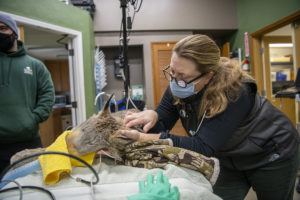
But there’s another, bigger reason for not wanting Nuka to get pregnant: Omak’s genes are currently very well represented in the population of zoo lynxes. Canada lynxes are endangered in Washington, threatened by a number of factors including forest fires and logging. So U.S. zoos, under the Species Survival Plan (SSP) programs, carefully monitor the lynxes in human care, making sure there’s a healthy diversity of genes to ensure a strong population.
In other words, Nuka might need to become a mother at some point. So for now, she has a one-year contraceptive implant – and today’s the day it’s getting replaced.
“It’s about the size of a rice grain,” explains Dr. Case, sensitive fingers feeling methodically over the skin behind Nuka’s big, black-tufted ears.
Meanwhile, veterinary technician Tracy Cramer is carefully drawing blood – Nuka will get a complete blood count to monitor her internal health, plus she’s part of a broader scientific study about blood types in wild cats – and Withers is finishing up the claw sheaths.
“Found it!” calls Dr. Case, and Cramer hands her the clippers.
A new implant
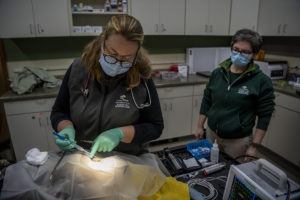
With smooth precision, the team assembles a miniature surgical set-up: drape with window, gauze and suture thread at the ready. Cramer gives a shot of local anesthetic to numb the area, then Dr. Case makes a tiny incision to remove the existing implant. Then, with a large syringe, she inserts the waxy white bead of the new contraceptive and neatly stitches up Nuka’s thick neck skin.
“All right, honey,” says Dr. Case warmly, stroking the big cat’s lush fur. Withers finishes cleaning out Nuka’s enormous ears and files her front claws.
After double-checking the exam checklist, Dr. Case gives the okay. Withers scoops Nuka up and lays her gently into a large crate, where she’ll be taken back to her bedroom to wake up and recover. She’ll rejoin Omak in a day or two.
“I’m really happy with how Nuka has progressed since we diagnosed her pancreatic insufficiency,” sums up Dr. Case. “I’ll make a note of it to the SSP, as it may be a factor in selecting her for breeding. But for now, she’s a healthy, happy lynx.”
